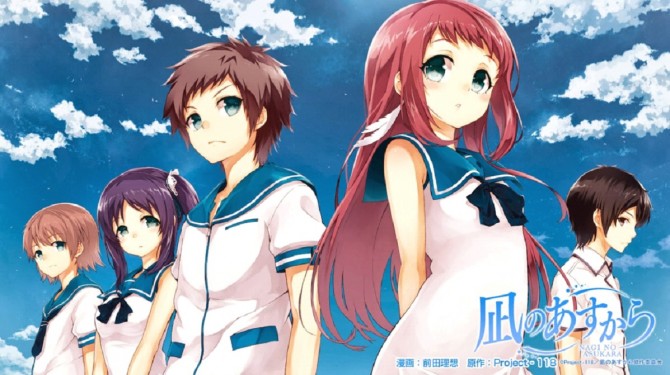Talk about a fish out of water! This is a standard high school romance anime, with a bit of a twist. “Nagi-Asu: A Lull in the Sea”, known in Japan as “Nagi no Asukara” (“From Calm Tomorrow”), takes a new tack on an old story. But first, let me bring down, from the Forbidden Shelf, a book. A book filled with lore and tales so fantastic, no one could believe them……except Steven Speilberg, who could turn it into a blockbuster movie.
Long ago, before cable TV, before transistor radios, before taxes, human civilization had lived on the ocean floor. However, there were many humans who wanted to live above the surface and they moved to land, creating a fundamental separation between the two. (Think of it like Red States and Blue States). Oshiooshi is the seaside village we are in, where, just below the surface is the sea people village of Shioshishio. After their school closes down, four middle school students from the sea have to go to school on the surface. This is about their lives as they adjust to a new environment and the relationships with each other.
Sounds simple? Not on your harpoon! We examine not only the lives of the five people up there, but the dynamic interaction between upper and lower residents, as each views the other with misgivings and distrust and distain.
Our five brave new worlders are (left to right) Kaname Isaki, Chisaki Hiradaira, Hikari Sakishima, Manaka Mukaido, and Tsumugu Kihara, their new friend from the surface. Now, you can readily identify the sea dwellers as they have really REALLY blue eyes. So, are they merfolk? Not really, as they do not sport the lower tail structure and are more amphibious, as they do well both on land and in sea.
They are covered in a thin shield called the Ena, which can dry and flake off, but just a simple dunking in salt water restores it. As they try to reconcile the two worlds, trouble brews. Much like King Triton in “The Little Mermaid”, the leaders of the underwater town want no interactions between sea folks and land folks….but it happens anyway and not always for the best. All these kids want is to get a real education, but they discover there are things that you cannot learn from a book and life is the best school of all.
One thing that perplexed me was these concrete stanchions. They come walking across the hillside, cut right into the ocean at the beach and move to a certain point before stopping. But, that’s all there is. Was this to be a framework for a monorail or a highway or other form of transportation? Why build it into the ocean? The salt water and wave action is going to weaken the structural integrity of it and it all comes crashing down, but no mention is made of it, so they are just there.
Perhaps it is symbolic! Perhaps we are making a statement that Man’s encroachment into the sea is both futile and dangerous and should not be permitted to occur? OK, they why not take them down? I have to assume that this is all snarled up in the courts and we have to wait for some degree of ruling on it.
The other is the varying degrees of hostility imparted on the sea kids. I mean, they are just another transfer student in. Or is this just the Japanese way? Everyone new is hazed so deal with it. It’s just when we threw in the twin arcs of the Ofunehiki Festival (a kind of sacrifice to the sea gods) and the saltflake snow (a natural phenomenon that closed the undersea school) you really wondered what it was all about. It seemed to me that comments were being made about respect for the past, embracing the future and all pulling together for the common good, but we weren’t really doing anything about it.
Then comes the A/B split. Much like “From the New World”, the ‘second season’ takes place five years later, but it takes them two episodes to tell us of the time shift and a lot has shifted. So, if things weren’t bad enough beforehand, when some of the students return, they technically have not aged, but their friends have. Then it gets into more romantic messes and the rest of the show falls into the sea like a rusted crane.
It is a good looking show, as the colors are very rich and deep. If only some of that color landed on the characters performing for us. It just feels like a key ingredient is missing.
On a scale of 1 to 10:
Artwork 8 (Interesting artwork and approaches)
Plot 8 (A simple plot done well)
Pacing 7 (Slows down at the end)
Effectiveness 7 (Too many cliches)
Conclusion 7 (It reaches a ‘coupler point’, but doesn’t really end)
Fan Service 6 (A similar show would be “Mahoromatic”)
Overall 8 (Well worth the gamble)
And remember, it’s first run until you’ve seen it. Contact is strictly forbidden.

Leave a Reply